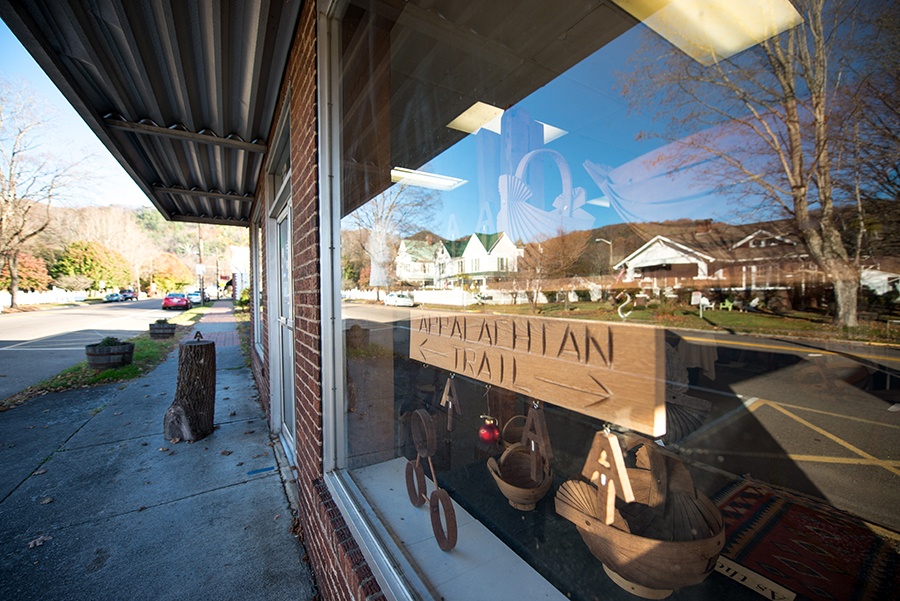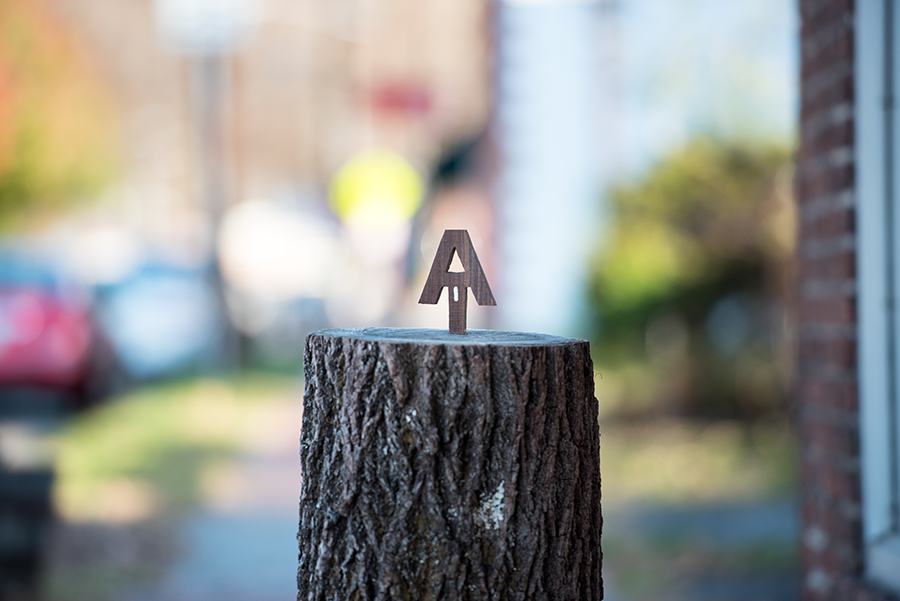Learn More
Damascus
A Common Thread
 Tucked into the hills of Southwest Virginia lies the tiny Town of Damascus. The official population hovers around 800 people, but for one weekend every Spring for the past 31 years, the town limits swell with hiking and trail enthusiasts for the annual Appalachian Trail Days Festival. In 2017, more than 20,000 people from 49 states and 22 countries gathered to celebrate the Trail, its people and culture.
Tucked into the hills of Southwest Virginia lies the tiny Town of Damascus. The official population hovers around 800 people, but for one weekend every Spring for the past 31 years, the town limits swell with hiking and trail enthusiasts for the annual Appalachian Trail Days Festival. In 2017, more than 20,000 people from 49 states and 22 countries gathered to celebrate the Trail, its people and culture.
Walking north on the A.T., Damascus is the first town hikers reach after crossing into Virginia from Tennessee. The Trail runs directly through the town’s center on Laurel Drive, past numerous accommodations, outfitters, restaurants, churches and other hiker-friendly amenities. The welcoming nature of the town’s residents and businesses has earned Damascus the “Friendliest Town on the Appalachian Trail” moniker, and it was one of the first towns along the footpath to be designated an A.T. Community in 2011.
But the A.T. is not the only trail in town. Six other trails run through Damascus — The Virginia Creeper Trail, The Crooked Road Heritage Music Trail, The Iron Mountain Trail, U.S. Bicycle Route 76, The Virginia Birding and Wildlife Trail, and The Daniel Boone Heritage Trail — which helps earn the town a second alias of “Trail Town USA.”
From Tree Tops to Rock Bottom
Since the A.T. was completed in 1937, the Trail and Damascus have been inseparable. But the Trail was not always the attraction it is today. In the beginning the footpath was difficult, rugged and challenging, and not many people were eager to conquer its entirety.
The Town of Damascus has experienced similarly rough times.
 For the first quarter of the 20th century, the timber industry was Damascus’s main economic driver. But by the late 1920s, logging operations were winding down after depleting much of the area’s old-growth forests. In the 1930s, the newly formed U.S. Forest Service purchased most of the land surrounding Damascus, allowing forests to recover under federal management. The Civilian Conservation Corps began constructing outdoor recreation facilities and trails in the hills surrounding the town.
For the first quarter of the 20th century, the timber industry was Damascus’s main economic driver. But by the late 1920s, logging operations were winding down after depleting much of the area’s old-growth forests. In the 1930s, the newly formed U.S. Forest Service purchased most of the land surrounding Damascus, allowing forests to recover under federal management. The Civilian Conservation Corps began constructing outdoor recreation facilities and trails in the hills surrounding the town.
With the timber industry no longer using the several railroad lines running through town, manufacturing companies moved in to take advantage of the established transportation routes. For the next 40 years, textile and chemical plants provided employment for the town’s population, which grew to around 1,700.
By the 1970s, overseas manufacturing and automation began shuttering many of the town’s employers. This also signaled the end for the railroads. By the 1980s, the town was left without any industry. Damascus residents began moving elsewhere to find opportunity, and by 1990, the town’s population had shrunk to around 900.
Damascus had hit rock bottom.
“All these things are connected. The trails, the trout fisherman, the runners. The future is bright for Damascus. We haven’t reached the finish line. We’re still developing. We’re blessed with what was created, and as long as we keep sharing, we’ll be just fine.”
Pedaling Economy
Around the same time, Damascus and the nearby town of Abingdon, Virginia, with the help of state and federal governments, began acquiring the rights to build a rail-to-trail path along an abandoned railroad bed. When the Virginia Creeper Trail was designated as a National Recreation Trail by Congress in 1987, many of the local residents thought the town was crazy to try to build a foot-powered economy.
 Tim Williams, a lifelong Damascus resident, Town Council member, and vice mayor, says several things helped fuel the town’s tourism and recreation economy. The 34-mile Creeper Trail hits its midway point in Damascus, and for 14 miles, bike riders can coast downhill, an easy ride for all ages. The area also has several other unique assets, including pristine trout streams that attract fisherman and National Forest lands that draw in other recreational users such as ultra-runners and equestrians.
Tim Williams, a lifelong Damascus resident, Town Council member, and vice mayor, says several things helped fuel the town’s tourism and recreation economy. The 34-mile Creeper Trail hits its midway point in Damascus, and for 14 miles, bike riders can coast downhill, an easy ride for all ages. The area also has several other unique assets, including pristine trout streams that attract fisherman and National Forest lands that draw in other recreational users such as ultra-runners and equestrians.
“We are blessed to have the beauty of the mountains and fortunate to have the federal lands.” Williams said. “You can’t ship those things abroad.”
According to the Outdoor Industry Association, the outdoor recreation economy generates $887 billion in annual consumer spending in the United States, which directly supports 7.6 million jobs and generates $125 billion in federal, state and local tax revenue. Investment in outdoor recreation infrastructure in Virginia generated nearly $22 billion in consumer spending in 2016, creating $1.2 billion in state and local taxes.
Williams notes that Damascus has not raised taxes in close to 20 years and has been able to grow the town’s police and public works departments, as well as the town’s office staff, due to the influx of meals and lodging tax revenues.
“The type of tourism and recreation that attracts so many people to Damascus has also brought a tax base we didn’t used to have,” Williams said.
Trails as Lifeblood
The growth of Damascus’s outdoor recreation economy didn’t happen overnight, according to Williams, who also serves as chair of the Trail Days committee.
“We hit rock bottom but the town has transitioned over time,” he said. “Damascus began the Trail Days Festival nearly 32 years ago. From there, the town and its reputation grew.”
Williams stated that increased Internet use in the past 10-12 years has helped spread the word about the town and its outdoor opportunities.
Damascus Town Manager Gavin Blevins describes Damascus as a heart, with the A.T. and Creeper Trail functioning as veins bringing lifeblood into the town. The Creeper Trail does more to drive economic development, while the A.T. brings in more culture.
“The A.T. brings a lot of interesting stories, relationships, activities, programs, all coming into this small town nestled in Southwest Virginia,” Blevins said. “We’re sheltered from a lot of what goes on in the rest of the nation. But the A.T. is the informational highway that brings all of that culture into Damascus. Other smaller towns in the region don’t have those viewpoints. They are not as broad in cultures, religions, languages.”
Williams agrees. “So many people have helped to diversify the culture and viewpoints in this town because we have such a variety of folks from everywhere, with all their education and experiences,” he said. “We’re enriched and elevated in Damascus. We all enjoy what this town has. That is our common thread and people want to get involved. That’s what really helped to drive the tourism economy.”
Bright Future
In 2013, the Town of Damascus began a strategic planning process to outline its vision for the next 10-20 years. According to Blevins, the town is undertaking several projects to leverage its outdoor recreation assets, including a downtown revitalization plan.
Williams notes Damascus has a few ideas to bolster its economy so businesses have more sustainable income year-round.
“What we really want to do is get people out of their cars and onto bikes or on foot to get downtown,” he said.
To accomplish this, the town is planning to install better directional signage and develop a downtown connector trail system to take visitors by the river and through more green spaces.
One of the largest projects involves the Town of Damascus partnering with the Appalachian Trail Conservancy and the Southwest Virginia Cultural Heritage Foundation to construct a 2,500-square-foot Appalachian Trail Center. With its completion slated for 2019, the center will support visitor information, exhibits on local trails and other outdoor attractions, and training seminars for a range of volunteers, including trail club members who help maintain the A.T.
“Having the skills and reputation of the Appalachian Trail Conservancy will be a huge boost to Damascus,” Williams said, noting how the A.T. is one of many of the area’s outdoor experiences.
With all of these elements falling into place, Williams is optimistic about his town’s future.
“All these things are connected,” he said. “The trails, the trout fisherman, the runners. The future is bright for Damascus. We haven’t reached the finish line. We’re still developing. We’re blessed with what was created, and as long as we keep sharing, we’ll be just fine.”
– by Alyson Browett, At-Large A.T. Community Ambassador
